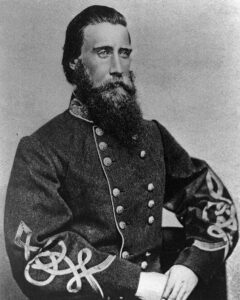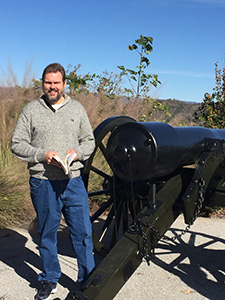A BGES Civil War Field University Program
With Norman Dasinger and Robert Jenkins
March 21-23, 2025; from Gadsden, AL
 After the fall of Atlanta in September 1864, Confederate General John Bell Hood led his battered Army of Tennessee northward through Big Shanty (Kennesaw), Acworth, Resaca, and Dalton, tearing up large portions of the Western & Atlantic Railroad and capturing small Federal garrisons along the way. His goal was to lure Union Gen. William T. Sherman into battle, hoping to defeat the Federals in north Georgia, while forcing Sherman to leave perhaps as much as half of his army behind to defend the recently captured city of Atlanta.
After the fall of Atlanta in September 1864, Confederate General John Bell Hood led his battered Army of Tennessee northward through Big Shanty (Kennesaw), Acworth, Resaca, and Dalton, tearing up large portions of the Western & Atlantic Railroad and capturing small Federal garrisons along the way. His goal was to lure Union Gen. William T. Sherman into battle, hoping to defeat the Federals in north Georgia, while forcing Sherman to leave perhaps as much as half of his army behind to defend the recently captured city of Atlanta.
Instead, Sherman pursued Hood to the Georgia-Alabama line near Rome with nearly all his of his forces, leaving only Union Maj. Gen. Henry W. Slocum and the XX Corps to guard Atlanta. Realizing he was still outnumbered, Hood moved west into Alabama, hoping to cross the Tennessee River at Guntersville and capture Stevenson, before advancing into Tennessee to threaten Nashville. Ironically, this dream of reclaiming the heart of the Volunteer State, and possibly Kentucky, had been the core Confederate strategy since 1862, dictating the Army of Tennessee’s movements from Perryville to the Stones River (Murfreesboro) and Chickamauga.
This same strategy—of recapturing Tennessee and halting North advances—had been the vision of Confederate President Jefferson Davis and his chief military advisor, Gen. Braxton Bragg, with Hood now carrying it forward.
Sherman, unwilling to cede momentum, pursued Hood into northwest Georgia, but eventually halted at Rome to plan his next offensive. He dispatched Maj. Gen. George H. Thomas to Nashville and sent Maj. Gens. John M. Schofield and David Stanley with their corps to block Hood’s advance into Tennessee. Sherman then sought the approval from Gen. Ulysses S. Grant, Maj. Gen. Henry Halleck, and President Abraham Lincoln to march toward Savannah, a campaign that would the famous (or infamous in the South) “March to the Sea.” For the first time in the war, two major armies marched in opposite directions, each pursuing its own objective.
Join Norman and Bob as we follow Hood’s Army of Tennessee through the Yellowhammer State—as Alabama is called—and examine the events, difficulties, and decisions that led to Hood’s delays and movements further and further to the west, culminating in a battle at Decatur, Alabama, where African American troops in the Union army faced Confederate veterans. After over a month of delays and supply issues, Hood eventually crossed the Tennessee River in west Alabama rather than east Alabama, before entering Tennessee, where his army was greeted with a sign at the state line: “Tennessee’s a free home, or a grave!”—foreshadowing the events to come.
How did Hood’s army reach Tennessee from Georgia? Why did they take so long to cross the Tennessee River? Why did Sherman not pursue them? What limitations did Hood and his army face along the way? How did the Black soldiers perform at the Battle of Decatur, and what was the ultimate outcome?
These questions and more will be explored as we retrace Hood’s steps across Alabama on this unique tour.
Itinerary
Friday evening, March 21, 2025, 6:00-7:00 p.m.: Orientation
Meet Norman and Bob at our headquarters hotel for a one-hour orientation covering the sights and events on the tour. Program materials will be distributed (or the next morning for late arrivals).
Dinner is on your own.
Saturday, March 22, 2025, 8:00 a.m.-5:00 p.m.
We will leave our hotel in Gadsden, Alabama, heading to Blue Mountain, the main supply depot for Hood’s army after the fall of Atlanta. En route, we will pass the site of the Pelham Farm, where Maj. John Pelham, famed artillerist at the Battle of Fredericksburg, grew up. Pelham delayed Federal troops at Fredericksburg while leading his artillery battery as part of Lt. Gen. J.E.B. Stuart’s cavalry; he was killed on March 17, 1863, at the Battle of Kelly’s Ford, near Culpeper, Virginia, by an exploding Federal shell fragment.
Next, we head to Jacksonville, Alabama, where we will visit the house where Beauregard quartered and learn about his efforts to supply Hood’s moving army. We will also see the grave of Pelham.
We will next go to Cave Spring, Georgia, and visit the Hearn House and other notable sites in this historic city. Cave Spring is home to over 90 structures listed on the National Register of Historic Places, and served as Hood’s headquarters. It was here he met with Gen. P.G.T. Beauregard to plan his offensive into Tennessee.
Following this, we will head to Gaylesville, Alabama, to visit Sherman’s headquarters. On the way, we will stop at Moshat Cemetery to see the grave and tombstone of George Jefferson Edkins, who was allegedly a member of the artillery battery that fired the first shot at Fort Sumter, marking the beginning of the war.
As we make our way back to Gadsden, we will visit the site of the little-known battle of Turkeytown, where Hood and Sherman faced off for the last time as opposing generals. We will conclude our day in Gadsden, exploring key sites from the 1863 Forrest-Streight Raid, as well as some historic Civil Rights locations.
As you can see, there will be plenty of bonus coverage as we continue tracing Hood’s march across North Alabama.
We will return to the hotel by 5 p.m. Lunch is included, but dinner is on your own.
Sunday, March 23, 2025, 8:00 a.m.-5:00 p.m.
Today, we will begin our westward journey, following Hood’s route to Somerville, Alabama. Hood made the critical decision to shift his army and base of supplies west, rather than risk crossing the Tennessee River at Guntersville, where Federal gunboats were patrolling the area. He moved his base to Somerville. Nearby, a Federal garrison defended Decatur, sheltered behind a range of earthworks anchored by small forts and flanked by the Tennessee River. Hood decided to challenge these defenses, which were partially manned by newly organized Black soldiers. We will explore this little-known battle in detail before proceeding to the home of Lt. Gen. Joseph Wheeler, where we will discuss the Confederate cavalry’s support—or lack thereof—during Hood’s Alabama Campaign.
We will finish the day and return to the hotel by 5:00 p.m. Lunch is included.
About the Faculty
 Norman Dasinger lives in Rainbow City, Alabama, where he is the owner of a real estate title company. He has been involved in Civil War history, preservation, and interpretation since 1985. He is a member of the Sons of Confederate Veterans (SCV), the Sons of Union Veterans of the Civil War (SUVCW), and Sons of the American Revolution (SAR). He has led Civil War tours across Alabama, Georgia, and Tennessee since 2004 and possesses extensive knowledge of the region’s history, including Civil War, pioneer, Native American, and Civil Rights history. Norman has two grown sons.
Norman Dasinger lives in Rainbow City, Alabama, where he is the owner of a real estate title company. He has been involved in Civil War history, preservation, and interpretation since 1985. He is a member of the Sons of Confederate Veterans (SCV), the Sons of Union Veterans of the Civil War (SUVCW), and Sons of the American Revolution (SAR). He has led Civil War tours across Alabama, Georgia, and Tennessee since 2004 and possesses extensive knowledge of the region’s history, including Civil War, pioneer, Native American, and Civil Rights history. Norman has two grown sons.
 Bob Jenkins is a practicing attorney in Dalton, Georgia, and an active preservationist. He has played a significant role in expanding the narrative of the 1864 Atlanta Campaign. Bob is known for his animated and detailed interpretations, offering new and thought-provoking historical perspectives. He has authored three books on the Atlanta Campaign, including The Battle of Peach Tree Creek; Hood’s First Sortie, July 20, 1864 (2013); and To the Gates of Atlanta: From Kennesaw Mountain to Peachtree Creek, July 1-19, 1864 (2015). His latest book, The Cassville Affairs: Johnston, Hood, and the Failed Confederate Strategy in the Atlanta Campaign, was published by Mercer University Press in February 2024.
Bob Jenkins is a practicing attorney in Dalton, Georgia, and an active preservationist. He has played a significant role in expanding the narrative of the 1864 Atlanta Campaign. Bob is known for his animated and detailed interpretations, offering new and thought-provoking historical perspectives. He has authored three books on the Atlanta Campaign, including The Battle of Peach Tree Creek; Hood’s First Sortie, July 20, 1864 (2013); and To the Gates of Atlanta: From Kennesaw Mountain to Peachtree Creek, July 1-19, 1864 (2015). His latest book, The Cassville Affairs: Johnston, Hood, and the Failed Confederate Strategy in the Atlanta Campaign, was published by Mercer University Press in February 2024.
Hotel Information
This program will be headquartered at Fairfield Inn, 116 Walker Street, Gadsden, Alabama, 35904; 256-538-2100. The BGES special hotel rate is $112 plus tax, with a rate cut-off date of February 19, 2025. When you call the hotel, be sure to tell them you are booking your room with the group “Blue and Gray Education” to get the special rate. The hotel does not have an airport shuttle.
Transportation
The servicing airport is Birmingham-Shuttlesworth International Airport (BHM), 53 miles from the hotel. Atlanta’s Hartsfield-Jackson International Airport (ATL) is also an option. It is 122 miles from the hotel.
Recommended Reading
You will receive maps and materials that will meet your onsite requirements. The following books are suggested to enhance your readiness for the program.
- Carpenter, Noel. A Slight Demonstration: Decatur, October 1864, Clumsy Beginning of Gen. John B. Hood’s Tennessee Campaign. Austin, TX: Legacy Books and Letters, 2007. ISBN 978-0615148663.
- Hood, Stephen M. John Bell Hood: The Rise, Fall, and Resurrection of a Confederate General. El Dorado Hills, CA: Savas Beatie, 2013. p. 335. ISBN 978-1611211405. OCLC 818954790.
- Jacobson, Eric A.; Rupp, Richard A. For Cause & for Country: A Study of the Affair at Spring Hill & the Battle of Franklin. Franklin, TN: O’More Publishing, 2007. ISBN 978-0971744448. OCLC 428436180.
- Kennedy, Frances H., ed. The Civil War Battlefield Guide (Kindle) (2nd ed.). Boston, MA: Houghton Mifflin Co., 1998. ISBN 978-0395740125.
- Sword, Wiley. The Confederacy’s Last Hurrah: Spring Hill, Franklin, and Nashville. Lawrence, KS: University Press of Kansas, 1993. ISBN 9780700606504. OCLC 1285470936.
- Thrasher, C.D. Suffering in the Army of Tennessee: A Social History of the Confederate Army of the Heartland from the Battles for Atlanta to the Retreat from Nashville. Voices of the Civil War series. Knoxville, TN: University of Tennessee Press, 2021. ISBN 978-1621906414.
Registration
To register by mail or fax, download this printable registration form: Hood’s Fall 1864 Campaign into Alabama.
Questions? Need more information? Please contact us.
